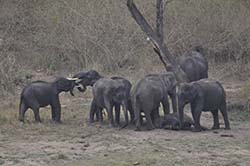
2019/8/25(日) 第58回京大モンキー日曜サロン
「ゾウの声を聴こう:ゾウどうしはどんなふうに会話するの?」 ナチケータ・シャルマ先生
「Hearing the Zos' voice: How do elephants' talk with each other?」 Nachiketha Sharma
「ゾウの声を聴こう:ゾウどうしはどんなふうに会話するの?」 ナチケータ・シャルマ先生
「Hearing the Zos' voice: How do elephants' talk with each other?」 Nachiketha Sharma
|
■日時:2019/8/25(日) 12:30~13:15 ■講師: ナチケータ・シャルマ先生(京都大学野生動物研究センター・大学院生) Nachiketha Sharma(Doctoral Student, The Wildlife Research Center, Kyoto University) ※プロフィールはこちら ■内容: アジアゾウは、血縁者の結束の強い、高度な社会性をもった動物です。 いくつかの群れが集まったり離れたりを繰り返す離合集散社会のなかで、 ゾウはするどい嗅覚を発達させ、声によるコミュニケーションを発展させてきました。 今回は、ゾウの社会における声の使い方とその役割についてご紹介します。 ゾウは、「トランペット音」「チューチュー声」「うなり声」「ゴロゴロ声」とさまざまなタイプの声を使います。 ときには「うなり‐ゴロゴロ」「ゴロゴロ‐うなり」というように組み合わせることもあります。 これらの声にはそれぞれ意味があり、異なる文脈で発せられます。 ゾウの声の使い分けを理解することは、彼らの福祉・保全を考えるうえでとても大事なことなのです。 (※本講演は英語でおこなわれますが、適宜、通訳をはさみます。) Asian elephants are long-lived and highly social animals living in closely bonded family units. With the fission-fusion society, elephants have developed a strong sense of smell and vocal communication for a better coordination. In this talk, I will introduce the use and roles of vocalizations in elephant societies. Elephants use various types of sounds- trumpets, chirps, roars and rumbles along with occasional combination calls roar-rumble and rumble-roar. With specific meaning, these signals are used in relation to different contexts. Understanding these behaviours are important for their welfare and conservation. ■対象年齢:小学校高学年以上 ※どなたでもご参加いただけますが、難易度等は上記に合わせて進行いたします |
    |



営業案内
友の会
園内マップ・施設紹介
アクセス

動物園イベント
モンキー日曜サロン
ミュージアムトーク
特別展
写生大会

学習利用のご案内
団体利用・実習・研修など
モンキーキャンパス
プリマーテス研究会
おうちどうぶつえん
研究室
博物館資料
連携研究
屋久島研修所
Web霊長類図鑑
霊長類和名リスト
国際学術誌「Primates」
雑誌「モンキー」
新JMC通信
歴史・定款・年報など
スタッフ紹介
全頭誕生日カレンダー
求人情報
取材等のお問合せ
サイト利用規定
| ※日本の動物園等で飼育されている霊長類の種数は102種類です。(2015年3月31日時点、GAIN調べ。種間雑種その他の分類不明なものは除く。) |












